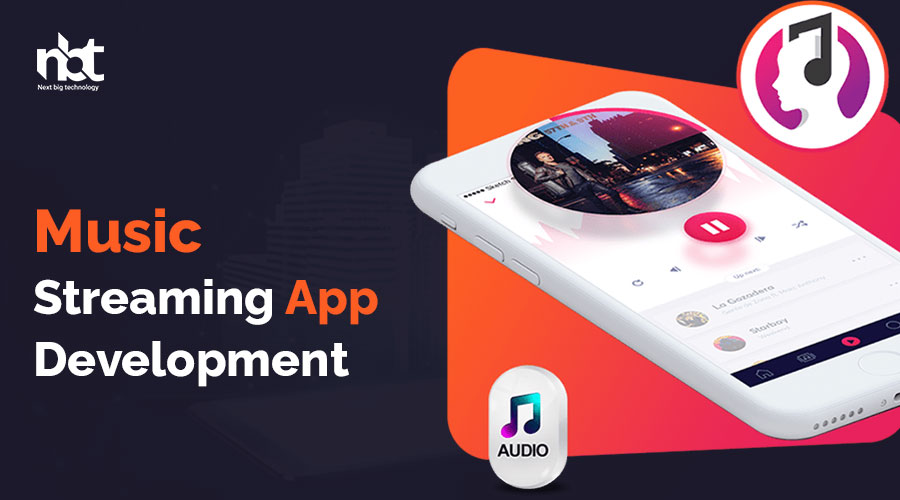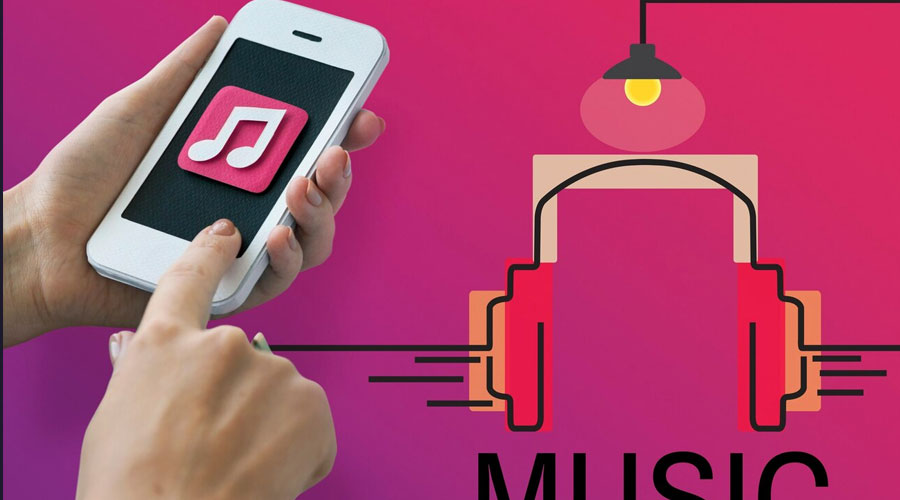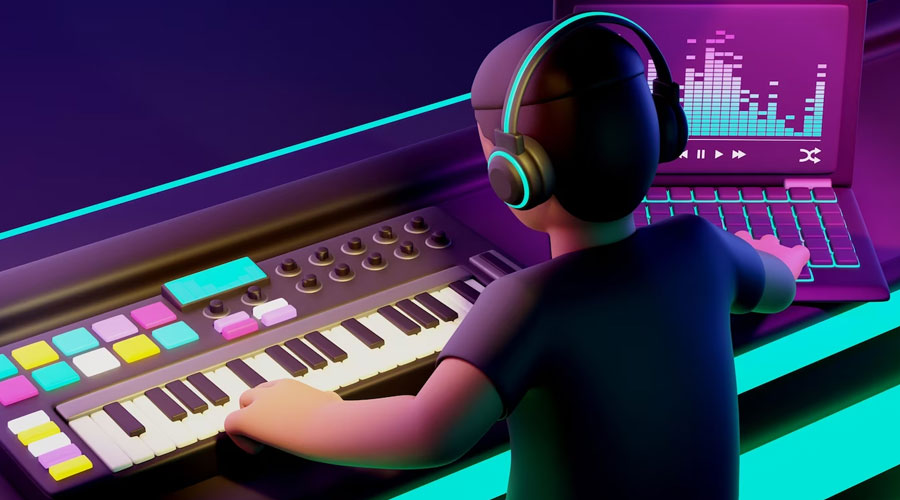Table of Contents
Introduction to Music Streaming App Development
In the ever-evolving landscape of the digital age, few industries have experienced as much transformation and innovation as the realm of music consumption. The advent of music streaming applications has not only disrupted traditional modes of listening but has also ushered in an era of unprecedented accessibility and convenience for music enthusiasts worldwide. This article seeks to provide an in-depth exploration of the multifaceted world of music streaming app development, unraveling the layers that contribute to the success and popularity of these digital platforms.
The Dawn of Digital Music Consumption:
The journey from vinyl records to cassette tapes, CDs, and eventually digital downloads has been marked by a continuous quest for convenience and portability. However, it was the emergence of music streaming that truly revolutionized the way we engage with and enjoy music. Gone are the days of physical media and cumbersome downloads; the modern consumer now demands instant access to an expansive library of songs at their fingertips.
Music streaming apps have not only democratized access to music but have also redefined the dynamics of the music industry itself. With the advent of pioneering platforms like Spotify, Pandora, Apple Music, and Amazon Music, users now have the power to explore, discover, and share their favorite tunes seamlessly, transcending geographical and cultural boundaries.
The Pioneers and Trailblazers:
One cannot discuss the landscape of music streaming without acknowledging the pioneers who paved the way for this digital revolution. Spotify, launched in 2008, is often credited as a trailblazer in the industry, introducing the concept of freemium models and personalized playlists. Its success laid the groundwork for other major players like Apple Music, which entered the scene in 2015, and Amazon Music, leveraging its extensive ecosystem, further diversifying the market.
Each of these platforms brought its own unique features and offerings to the table. While Spotify excelled in algorithm-driven personalized recommendations and social sharing, Apple Music capitalized on its integration with the Apple ecosystem and exclusive artist collaborations. Amazon Music, with its robust integration into the Amazon Prime subscription service, targeted a broad audience, offering additional value beyond music alone.
Key Features Shaping the User Experience:
- User-Friendly Interface:
- The cornerstone of any successful music streaming app is an intuitive and user-friendly interface. Navigability, simplicity, and a visually appealing design contribute significantly to user engagement and retention.
- Content Library and Licensing:
- The backbone of a music streaming service lies in its content library. Establishing licensing agreements with record labels and artists is not just a legal prerequisite but a strategic necessity to ensure a vast and diverse collection of music that caters to the eclectic tastes of a global audience.
- Offline Mode for On-the-Go Listening:
- Recognizing the importance of accessibility, many streaming apps offer an offline mode, enabling users to download their favorite tracks and playlists. This feature caters to users in areas with limited connectivity and those who prefer not to rely on streaming data.
- Personalization and Recommendations:
- The integration of advanced algorithms for personalized recommendations is a game-changer. By analyzing user preferences, listening history, and behavior, these platforms provide a tailor-made musical experience, keeping users engaged and satisfied.
- Social Integration and Collaborative Playlists:
- Music is inherently social, and successful streaming apps leverage this by integrating social features. Users can share their favorite tracks, playlists, and even collaborate on playlists with friends, fostering a sense of community within the app.
- Cross-Platform Compatibility:
- In a world of diverse devices and operating systems, cross-platform compatibility is paramount. Developing apps that seamlessly work across various platforms and devices ensures a broader user base and increased accessibility.
Key Features and Functionality of Music Streaming Apps
The realm of music streaming apps is constantly evolving, driven by technological advancements and the ever-changing demands of users. As these platforms strive to offer a more immersive and personalized musical experience, the integration of innovative features and functionalities becomes paramount. In this comprehensive exploration, we will delve deeper into the key features and functionalities that define the contemporary landscape of music streaming apps, elevating the user experience to new heights.
-
High-Quality Audio Streaming:
The quality of audio streaming is a cornerstone of any music streaming app. Offering high-quality audio, including options for lossless or high-bitrate formats, ensures that users can enjoy their favorite tracks with unparalleled clarity and fidelity. This feature has become particularly relevant with the rise of premium subscription models, where users are willing to pay for enhanced audio quality.
-
AI-Powered Music Recommendations:
Artificial Intelligence (AI) plays a pivotal role in enhancing user engagement through intelligent music recommendations. By analyzing user preferences, listening habits, and contextual data, AI algorithms can suggest personalized playlists, discover new artists, and recommend songs that align with the user’s taste. This level of personalization not only keeps users engaged but also introduces them to a broader spectrum of music.
-
Podcasts and Audio Content:
Beyond music, successful streaming apps have diversified their content offerings to include podcasts, interviews, and audio shows. This expansion broadens the app’s appeal, attracting users interested in more than just music. Seamless integration of podcasts alongside music libraries contributes to a more holistic entertainment platform.
-
Lyrics Integration:
The inclusion of synchronized lyrics enhances the overall listening experience. Users can sing along, understand the meaning behind the lyrics, and connect more deeply with the music. Providing a karaoke-like experience within the app adds an interactive dimension, making it a valuable feature for users.
-
Social Sharing and Collaborative Playlists:
Social integration goes beyond sharing favorite tracks on social media. Music streaming apps now allow users to create collaborative playlists, enabling friends to contribute to a shared musical experience. This social dimension fosters a sense of community among users and expands the app’s reach through user-generated content.
-
Live Streaming and Virtual Concerts:
The integration of live streaming and virtual concerts brings a real-time, immersive experience to users. Streaming apps can host live performances, exclusive interviews, and virtual concerts, connecting artists directly with their fan base. This feature has gained prominence, especially in a time when live events faced restrictions.
-
Adaptive Streaming and Offline Modes:
Adaptive streaming adjusts the audio quality based on the user’s internet connection, ensuring a seamless listening experience even in varying network conditions. Additionally, offline modes allow users to download their favorite tracks for offline listening, addressing concerns related to data usage and accessibility.
-
Integration with Smart Devices:
Music streaming apps are increasingly integrating with smart devices and home automation systems. This includes compatibility with voice-activated assistants, smart speakers, and connected home audio systems. Users can control their music playback through voice commands, offering a hands-free and convenient experience.
Cross-Platform Compatibility in Music Streaming Apps
In the ever-evolving landscape of digital music consumption, the demand for cross-platform compatibility in music streaming apps has become more pronounced than ever. Users today expect a seamless transition between their smartphones, tablets, desktops, and smart speakers, necessitating music streaming apps to transcend device boundaries. In this comprehensive exploration, we delve into the crucial role of cross-platform compatibility in music streaming app development, the challenges faced, and the strategies to ensure a harmonious listening experience across various devices.
Understanding Cross-Platform Compatibility:
Cross-platform compatibility refers to the ability of an application to function seamlessly across different operating systems and devices. In the context of music streaming apps, this implies that users should be able to access their favorite tunes and playlists regardless of whether they are using an iOS or Android device, a Windows PC, or a smart speaker.
Key Devices and Platforms in the Music Streaming Landscape:
- Smartphones and Tablets (iOS and Android):
- With the majority of users accessing music on their mobile devices, ensuring compatibility with both iOS and Android platforms is paramount. Music streaming apps need to leverage the unique features of each operating system while providing a consistent user experience.
- Desktops and Laptops (Windows and macOS):
- Many users prefer listening to music while working or relaxing on their computers. Cross-platform compatibility extends to desktop and laptop environments, requiring seamless integration with both Windows and macOS operating systems.
- Smart Speakers and Connected Devices:
- The rise of smart speakers and IoT (Internet of Things) devices has introduced a new dimension to music streaming. Compatibility with platforms such as Amazon Alexa, Google Home, and Apple HomePod is essential for an all-encompassing user experience.
Challenges in Achieving Cross-Platform Compatibility:
- Diverse Ecosystems:
- Each operating system comes with its own set of guidelines, design principles, and development tools. Adapting an app to meet the requirements of iOS, Android, Windows, and macOS can be a complex task, requiring expertise in multiple technologies.
- User Interface Consistency:
- Maintaining a consistent user interface (UI) and user experience (UX) across different platforms is challenging. Design elements, navigation structures, and interactions must align with the expectations of users on each specific platform.
- Hardware and Performance Variations:
- Devices within the same platform can vary significantly in terms of hardware specifications and performance capabilities. Optimizing the app for diverse devices without compromising performance is a delicate balance.
- Platform-Specific Features:
- Each platform offers unique features and functionalities. Leveraging these platform-specific capabilities while ensuring a cohesive experience across platforms requires meticulous planning and execution.
Strategies for Successful Cross-Platform Compatibility:
- Utilize Cross-Platform Development Frameworks:
- Cross-platform development frameworks like React Native, Flutter, and Xamarin enable developers to write code once and deploy it across multiple platforms. This approach streamlines the development process and facilitates consistent user experiences.
- Responsive Design Principles:
- Implementing responsive design principles ensures that the app’s interface adapts seamlessly to different screen sizes and resolutions. This is particularly crucial for devices ranging from smartphones and tablets to desktop monitors.
- APIs and Web Services:
- Utilize standardized APIs (Application Programming Interfaces) and web services to establish communication between the app and various platforms. This approach enables data synchronization and ensures a synchronized music streaming experience.
- Cloud-Based Solutions:
- Leveraging cloud-based solutions for data storage and processing can contribute to the seamless synchronization of user data and preferences across multiple devices. This approach ensures that users can pick up where they left off, regardless of the device they are using.
Case Studies in Cross-Platform Compatibility:
- Spotify:
- Spotify, one of the leading music streaming platforms, has successfully achieved cross-platform compatibility. Users can seamlessly switch between smartphones, tablets, desktops, and smart speakers, experiencing a consistent interface and access to their entire music library.
- Apple Music:
- Apple Music is designed to work seamlessly across iOS devices, macOS, Windows, and even Android. The app leverages Apple’s ecosystem while ensuring that users on other platforms have access to a comparable experience.
- Amazon Music:
- Amazon Music caters to a diverse audience with its compatibility across iOS, Android, Windows, macOS, and various smart speakers, including those with Amazon Alexa integration. The app’s success lies in its ability to adapt to the preferences and devices of its wide user base.
Emerging Technologies in the Music Streaming Industry
The landscape of the music streaming industry is continually evolving, driven by technological advancements that enhance user experiences and redefine the way we interact with music. In this in-depth exploration, we’ll delve into the emerging technologies shaping the future of music streaming, and how these innovations are poised to revolutionize the industry.
-
Artificial Intelligence (AI) and Machine Learning:
The integration of AI and machine learning has already made significant strides in the music streaming realm. These technologies are being employed to analyze user preferences, behavior, and listening patterns to deliver personalized recommendations. AI algorithms can understand the nuances of individual taste, suggesting tracks that align with users’ unique preferences. As these technologies continue to mature, we can expect even more accurate and sophisticated recommendation systems.
-
Voice Recognition and Virtual Assistants:
Voice-activated technology has become ubiquitous, with virtual assistants like Amazon’s Alexa and Google Assistant playing a central role in our daily lives. In the context of music streaming, users can now use voice commands to search for songs, create playlists, and control playback. Integrating voice recognition into music streaming apps not only enhances user convenience but also opens up new possibilities for hands-free music exploration.
-
Blockchain Technology:
Blockchain is making waves in the music industry by addressing long-standing issues related to royalty payments, copyright infringement, and transparency. By creating a decentralized and immutable ledger, blockchain ensures that artists receive fair compensation for their work and streamlines the complex royalty distribution process. This technology has the potential to revolutionize the way musicians are compensated and could lead to more equitable arrangements within the industry.
-
Spatial Audio and 3D Sound:
The advent of spatial audio technology is transforming the listening experience by adding a three-dimensional aspect to sound. With the rise of platforms like Dolby Atmos and Sony 360 Reality Audio, music streaming services are embracing spatial audio to create immersive environments for users. This technology allows artists to experiment with new ways of composing and arranging music, providing listeners with a more engaging and realistic auditory experience.
-
5G Technology:
The rollout of 5G networks is set to have a profound impact on music streaming. With faster and more reliable internet connections, users can expect quicker downloads, seamless streaming without buffering, and improved overall performance. High-quality audio streaming and the potential for augmented reality (AR) or virtual reality (VR) applications within music platforms become more feasible with the widespread adoption of 5G technology.
-
Augmented Reality (AR) and Virtual Reality (VR):
AR and VR technologies are gradually finding their way into the music streaming space, offering users immersive experiences beyond traditional audio. Virtual concerts, interactive music videos, and virtual environments where users can explore music in three-dimensional spaces are becoming a reality. These technologies have the potential to redefine the concept of live performances and bring artists and fans closer together in innovative ways.
-
Biometric Data Integration:
The incorporation of biometric data, such as heart rate and mood tracking, into music streaming apps adds another layer of personalization. By analyzing biometric indicators, apps can curate playlists that match users’ emotional states or energy levels. This level of customization goes beyond musical preferences, creating a more holistic and adaptive listening experience.
Implementing Social Features and User Interaction
In the ever-evolving landscape of music streaming apps, the integration of social features and fostering user interaction has become a pivotal aspect. Beyond providing a vast library of songs, users now seek a more immersive and communal experience. In this article, we will delve into the significance of social features, their impact on user engagement, and how developers can successfully implement these elements into music streaming applications.
Understanding the Importance of Social Features:
- Community Building:
- Music has always been a shared experience. By integrating social features, music streaming apps can create a virtual space for users to connect, share, and discuss their favorite tracks. This sense of community fosters a deeper connection between users and the platform.
- User Engagement:
- Social features enhance user engagement by allowing users to interact with the app beyond just listening to music. Features such as comments, likes, and sharing playlists contribute to a more dynamic and participatory user experience.
- Discovery and Recommendations:
- Social interactions provide valuable data that can be used to enhance recommendation algorithms. Analyzing what users share, like, or comment on allows the app to offer more accurate and personalized music recommendations, fostering user discovery.
Key Social Features to Implement:
- User Profiles:
- Enable users to create profiles where they can showcase their favorite artists, genres, and playlists. This not only adds a personal touch but also facilitates connections with like-minded users.
- Social Sharing:
- Implement sharing functionalities that allow users to share their current listening activity, favorite songs, or entire playlists on various social media platforms. This promotes the app organically and brings in new users.
- Collaborative Playlists:
- Foster collaboration by allowing users to create and share playlists with friends. This feature encourages social interaction within the app, as users can contribute songs and discover new tracks collaboratively.
- In-App Messaging:
- Integrate a messaging system within the app to facilitate direct communication between users. This enhances the social experience, allowing users to discuss music, share recommendations, and build connections.
- User Reviews and Ratings:
- Enable users to leave reviews and ratings for songs or albums. This not only provides valuable feedback to artists but also helps other users discover high-quality music based on peer recommendations.
- Live Streaming and Events:
- Consider incorporating live streaming features for exclusive artist events, interviews, or live performances. This not only adds a real-time element to the app but also creates a sense of excitement and exclusivity for users.
Implementing User Interaction:
- Gamification:
- Introduce gamification elements to incentivize user interaction. Achievements, badges, and rewards for activities like creating playlists, discovering new artists, or reaching milestones can enhance user engagement.
- Polls and Surveys:
- Engage users by conducting polls and surveys within the app. This not only provides valuable insights into user preferences but also makes users feel heard and involved in the development of the platform.
- User-Generated Content:
- Encourage users to contribute content, such as creating and sharing unique playlists, writing reviews, or even submitting their own music. This not only adds diversity to the content but also empowers users to actively participate in the platform.
- Personalized Notifications:
- Implement personalized notifications to keep users informed about new releases, upcoming events, or activities related to their favorite artists and genres. Tailoring notifications to individual preferences enhances user engagement.
- Virtual Events and Challenges:
- Organize virtual events or challenges within the app, such as themed playlist challenges or live streaming events. This not only creates a sense of community but also provides users with unique and interactive content.
Challenges and Considerations:
- Privacy Concerns:
- Balance the implementation of social features with user privacy. Clearly communicate privacy settings, allowing users to control the visibility of their activities and interactions.
- Moderation and Content Control:
- Implement robust moderation tools to control user-generated content and ensure a positive and safe environment. This is crucial to prevent misuse and maintain the integrity of the platform.
- Scalability:
- Plan for scalability as user interactions increase. Ensure that the infrastructure can handle a growing user base and the associated data generated through social interactions.
Conclusion:
Developing a music streaming app requires a combination of technical expertise, industry knowledge, and a deep understanding of user preferences. By focusing on key features, a user-friendly interface, and strategic development processes, developers can create a successful and sustainable music streaming app that resonates with a diverse audience. The continuous evolution of technology and user expectations makes this a dynamic and exciting field for developers to explore.
Thanks for reading our post “Music Streaming App Development”. Please connect with us to learn more about On-Demand App Clone.














